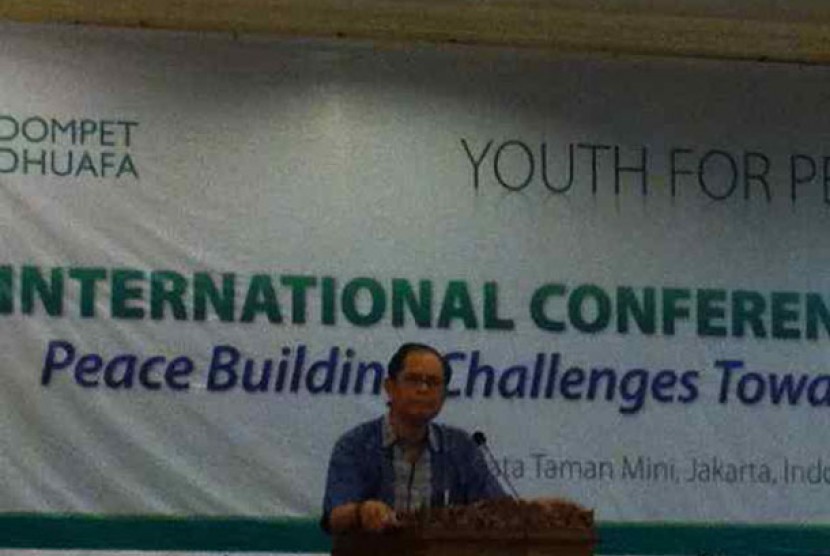REPUBLIKA.CO.ID, By Parni Hadi*
I. INTRODUCTION
It is a great pleasure for me to be invited to speak before a group of young people dedicated themselves to building peace.
Who change the world? The answer is: young people and media. Young people are identical with change. Youth has been always spearheads for a change any time, any where. Young people are changers in local, national and global levels. Be it in political, sosial and cultural fields. Young people are known for their strong will, lack of patience, desiring whatever they want come into being immediately. Young people are aspiring for the future., anti establishment. They are revolutionaries compared to older people who tend to be statusquoers.
A change often causes conflict. How can we make a change without causing unnecessary conflicts? The conflict can be easily accelerated to become worst uncontrollably due media reports, moreover in the present digitalized, interned-based information society. On the contrary, media can alo help revolutionary young people achieving their goals as well as controlling conflicts and reconciling warring parties.
Therefore, young people should understand ways how to deal with media.
NEW EMERGING FORCES
Digital technology has developed internet-based communications as the latest state of the art of communications technology. The interned-based social media, including Facebook and Twitter, dubbed as “new” media, have become a new player as well as a new center of power, leaving behind the “old” media (newspapers/magazines, radio and television stations).
The new media have enabled almost all people, particularly young people to be journalists, preachers, teachers, opinion makers and “content providers” that can publish and broadcast their ideas directly.
The new individual “content providers” through their social networks have become “new emerging forces”, “old established forces”.
The “new” emerging media have been developing rapidly with an ever growing influence in the ideological, political, social and economic fields throughout the world. They have prompted democratization process, forcing the downfalls of long-serving rulers of a number of Muslim countries in the Middle East.
What is continuing to happen in the Middle East now, where some rulers are threatened to step down, has given us an invaluable lesson learnt: Technology and Democracy are closely related and unstoppable!
Technology and Democracy have great influences on how people communicate. Technology has made messages reach the target more easily (cheaper and faster). Democracy has enabled people to express and communicate their dreams, ideas and hopes without fear of being punished by rulers and leaders.
More sophisticated technologies make communications easier, faster and cheaper. More freedom of expression as a product of democracy produces more ideas. Less technology and less democracy make communications difficult, blocking ideas to come out.
Realizing that Technology and Democracy are very closely related and unstoppable, the Muslim World has no other choice now but mastering the digital technology and promoting democracy, which gives more freedom of expression.
Life without freedom of expression is obsolete and old fashioned, but “too much” freedom or “freedom without boundaries” exercised by journalists and media, particularly the social media, has negative impacts on the population as shown by moral decadence of the younger generations, which is attributed by “older generations” to free access to pornography websites. But CORRUPTION done by “older generations” is not less dangerous than pornography.
PEACE JOURNALISM
Media, old and new, are using or trading words and pictures to reach their objectives. For the purpose of peace, the selection of words and pictures to be broadcast or published is of vital importance.
A simple advice, just avoid provocative words and pictures that can stimulate anger. On the contrary, choose words and pictures that can prompt positive responses.
Diction, time of publication and target audience must be carefully considered. Use humors and carricatures that can easily invite immediate smile and laughters.
Features with consoling topics of love, beauty, women and children plus relevant jokes and related attractive photos must be given top priority, rather than hard political or economic straight news.
When there is an error in the publication, make rectification honestly soonest.
Invite both sides of the conflicting parties to exchange words and photos through your media. If we think after some times the warring parties have reached common understanding, mutual interests and mutual respects, you could invite them to meet face to face in a relaxed and funny social gatherings.
Song festival, culinary, fashion and cultural shows with the partiicipation of leaders of both parties are highly recommended. Friendship sport competitions are also recommendable. This kind of practices is named peace journalism.
Peace journalism is seeking for peaceful solutions accepted by the conflicting parties. Peace is the ultimate goal of this journalism. Young people as peace builders and peace keepers should applly peace journalism by using “old” media and “media”.
Next>>>


